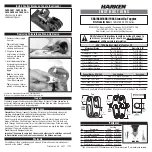
28
·
Simplify troubleshooting. Test one device/cable at a time and take notes.
·
Test all HDMI cables for functionality/capability before installation. Just one defective or insuffi
-
cient HDMI cable can bring down the entire system.
·
If using short HDMI cables it is recommended to try a longer cable.
The minimum length for
an HDMI cable per HDMI Specifications is 2 meters. If you are using short cables (.5m, 1m) it
is recommended to try a longer cable (2 meter minimum) as the short cables may cause sync/
signal issues.
·
Traditional copper based HDMI cables can be unreliable if longer than 4 meters (depending on
the build quality). The simple solution would be to use shorter copper based HDMI cables, but
if that is not possible you should consider using Active HDMI cables, AOC (Active Optical Ca
-
ble), or an HDMI extender.
·
If using an HDBaseT extender do NOT use pass through style RJ45 connectors when terminat-
ing the category cable. These style connectors can cause alien crosstalk and may cause inter
-
mittent issues or a complete system failure. When testing category cable avoid using a stan
-
dard continuity tester as a continuity test is only verifying that the wires are paired correctly.
It does NOT test the cable's capability of passing a high frequency video signal, audio, power,
Ethernet, or control signals. For certifying HDBaseT cabling we recommend using the MSTest
Pro. This piece of test equipment will help verify the Category cable length and capability. The
cable may be longer than what the HDBaseT extender is capable of (refer to manufacturer's
specifications for maximum transmission distance).
Note: HDBaseT is designed to have a point to point connection without any breaks (patch
cords, punch-downs, splices, coupler, etc) in the category cable/signal path between the trans
-
mitter and receiver. Any breaks in the cable WILL CAUSE ISSUES.
Troubleshooting tips
Discolored video
- Discolored video is generally associated with a color space mis
-
match. Using the analyzer in place of the display press the INFO button to view the signal info and
verify whether the colorspace is RGB or YCbCr (YCbCR, YUV, YCC, and YC are all interchangeable).
If there is a mismatch in color space between the source and the sink you may see the image but
the image is discolored (typically green or purple). Using the generator in place of the source, inject
a video signal into the system (it is recommended to use the SMPTE bar test pattern). Switch be
-
tween RGB and YCbCr and verify that the image is no longer discolored. If it is still discolored, move
the generator downstream from device to device until you find the device that is unnecessarily
converting the color space.





































